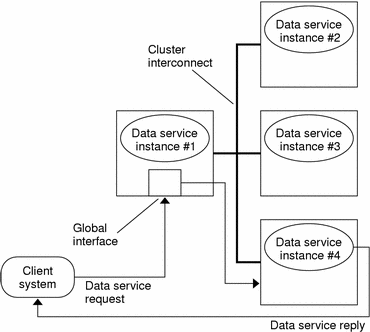Scalable Service Architecture
The primary goal of cluster networking is to provide scalability for data services. Scalability means that as the load offered to a service increases, a data service can maintain a constant response time in the face of this increased workload as new nodes are added to the cluster and new server instances are run. We call such a service a scalable data service. A good example of a scalable data service is a web service. Typically, a scalable data service is composed of several instances, each of which runs on different nodes of the cluster. Together these instances behave as a single service from the standpoint of a remote client of that service and implement the functionality of the service.We might, for example, have a scalable web service made up of several httpd daemons running on different nodes. Any httpd daemon may serve a client request. The daemon that serves the request depends on a load-balancing policy. The reply to the client appears to come from the service, not the particular daemon that serviced the request, thus preserving the single service appearance.
A scalable service is composed of:
-
Networking infrastructure support for scalable services
-
Load balancing
-
Support for networking and data services (using the Resource Group Manager)
The following figure depicts the scalable service architecture.
Figure 3-8 Scalable Service Architecture

The nodes that are not hosting the global interface (proxy nodes) have the shared address hosted on their loopback interfaces. Packets coming into the global interface are distributed to other cluster nodes based on configurable load-balancing policies. The possible load-balancing policies are described next.
- © 2010, Oracle Corporation and/or its affiliates
